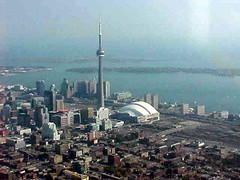Also discussed here: The Big Move: A sneak peek at Metrolinx’s short list of ‘revenue tools’ for expanded transit(Tess Kalinowski , Toronto Star, Apr. 2, 2013)
And here: Toll roads work but don’t use them to subsidize public transit(National Post, Andrew Coyne, Apr. 3, 2013)
Today we review a report which assessed a wide range of possible revenue options to cover the $50 B cost of improved public transit over the next 25 years for the Greater Toronto Hamilton Area (GTAH), the largest population centre in Canada. While a downtown cordon congestion charge was not recommended because of a lack of alternative mobility modes, an innovative vehicle mileage charge (VKT) using GPS technology was suggested that could generate almost $2B/yr in the next decade, as well as highway tolls that could generate up to $1.5 B/yr and reduce the demand for road use and the resulting pollution. The report includes a useful analysis of revenue potentials from existing congestion pricing experiences in London, Stockholm, and Manchester. Journalist and road pricing advocate,
Andrew Coyne, cautions against road pricing to subsidize public transit. Road pricing can reduce congestion and the resulting more smoothly running traffic benefits both those who use the roads and those who use transit. THAT becomes the attraction to encourage drivers to use transit, not cheaper fares as passengers seek quicker commute times (and convenience and comfort) above other points. As for the drivers, without some check on road use via appropriate pricing, any speed-up of traffic would be temporary and congestion would redevelop. Further, subsidized public transit contributes to sprawl which road pricing discourages. A final selection of options will be part of a strategy to be proposed by Metrolinx, the transit authority, for government approval in June 2013 following extensive public consultation.
 |
| Toronto Skyline (Photo credit: Bobolink) |
Key Quotes:
“recommendations for raising $2 billion annually for the next 25 years — the amount estimated in Metrolinx’s 25-year, $50-billion Big Move regional transportation plan”
“some innovative schemes that might be piloted locally. One — an odometer tracking or GPS-based technology system — would see Toronto area motorists charged for each kilometre they travel in the region.”
“The point of a toll, like any price, is to charge people the full cost of their use of resources. The point of a subsidy is to hide the true costs from them: in this case, to induce more people to use transit than would do if they had to pay the full price”
“subsidizing transit contributes to another problem more typically blamed on private cars: sprawl”
Some specific options:
“Development charges …A boost of $2,000 to $3,000 per new residential unit would generate $25 million to $50 million per year..
Employer payroll tax .. based on the employer’s proximity to transit lines. .. could raise between $810 million and $920 million by 2021…
Gas tax : A 0.5-cent/litre fuel tax could raise $300 million to $400 million a year by 2021..
High-occupancy toll lanes..could generate between $160 million and $250 million...
Highway tolls..could raise up to $1.5 billion a year at a cost of 10 cents/km..
Land value capture : Developers could end up paying more for land in the vicinity of specific transit improvements..
Parking space levy .. a charge of $1 per space per day, it could generate $1.4 billion to $1.6 billion...
Property tax : Based on the assumption of $7.7 billion in property taxes raised in 2010, a 5.2 per cent increase could raise up to $650 million in 2021…
Sales tax : A 1 per cent sales tax applied to all consumer goods in the region could generate up to $1.6 billion...
Transit fare increase..A 10-cent increase on 618 million annual transit trips in the Toronto region could generate up to $45 million...
Vehicle kilometres travelled ..a charge of .03 cents/km might generate up to $1.9 billion by 2021, taking into account the inevitable reduction in trips as drivers adjust their habits. Implementing such a system would be costly but could dramatically affect driver behaviour as well as raising funds.”











No comments:
Post a Comment